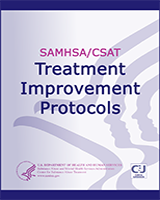NCBI Bookshelf. A service of the National Library of Medicine, National Institutes of Health.
This TIP, Continuity of Offender Treatment for Substance Use Disorders from Institution to Community, spotlights the important moment in recovery when an offender who has received substance use disorder treatment while incarcerated is released into the community. The TIP provides those who work in the criminal justice system and in community-based treatment programs with guidelines for ensuring continuity of care for the offender client.
Treatment providers must collaborate with parole officers and others who supervise released offenders. The TIP explains how these and other members of a transition team can share records, develop sanctions, and coordinate relapse prevention so that treatment gains made "inside" are not lost.
Offenders generally have more severe and complex treatment needs than many substance use disorder treatment clients, which makes case management an ideal approach. The TIP devotes a chapter to ancillary services such as housing and employment. These needs must be addressed if the client is to remain sober. Finally, the TIP presents treatment guidelines specific to populations such as offenders with mental illness, offenders with long-term medical conditions, and sex offenders. Appendixes include assessment instruments and a sample transition plan. This TIP represents another step by CSAT toward its goal of bringing national leadership to bear in the effort to improve substance use disorder treatment in the United States.
Contents
- What Is a TIP?
- Editorial Advisory Board
- Consensus Panel
- Foreword
- Executive Summary and Recommendations
- Chapter 1—Introduction
- Chapter 2—Case Management and Accountability
- Chapter 3—Guidelines for Institution and Community Programs
- Chapter 4—Administrative Guidelines
- Chapter 5—Ancillary Services
- Chapter 6—Special Populations
- Appendix A -- Bibliography
- Appendix B—Instruments
- Appendix C — Resource Panel
- Appendix D—Field Reviewers
- Tables and Figures
This publication is part of the Substance Abuse Prevention and Treatment Block Grant technical assistance program. This publication was written under contract number ADM 270-95-0013. Sandra Clunies, MS, ICADC, served as the CSAT government project officer. Rose M Urban, MSW, JD, CSAC, served as the CDM project director. Other CDM TIPs personnel included Y-Lang Nguyen, production/copy editor; Raquel Ingraham, MS, project manager; Virginia Vitzthum, former managing editor; and MaryLou Leonard, former project manager.
The opinions expressed herein are the views of the Consensus Panel members and do not reflect the official position of CSAT, SAMHSA, or the U.S. Department of Health and Human Services (DHHS). No official support or endorsement of CSAT, SAMHSA, or DHHS for these opinions or for particular instruments or software that may be described in this document is intended or should be inferred. The guidelines proffered in this document should not be considered as substitutes for individualized patient care and treatment decisions.
